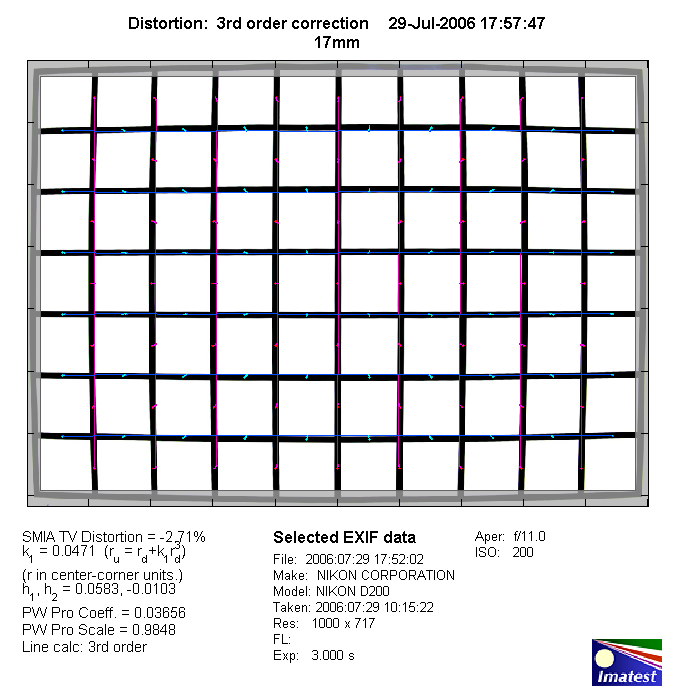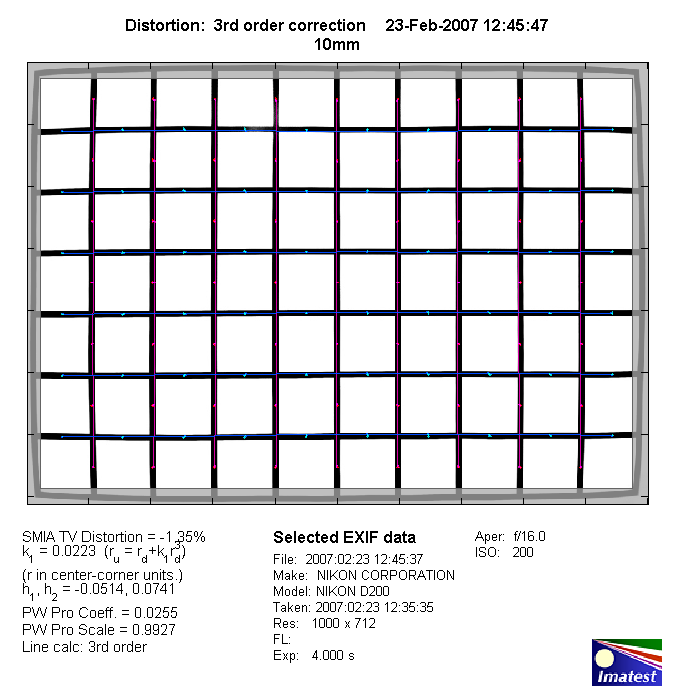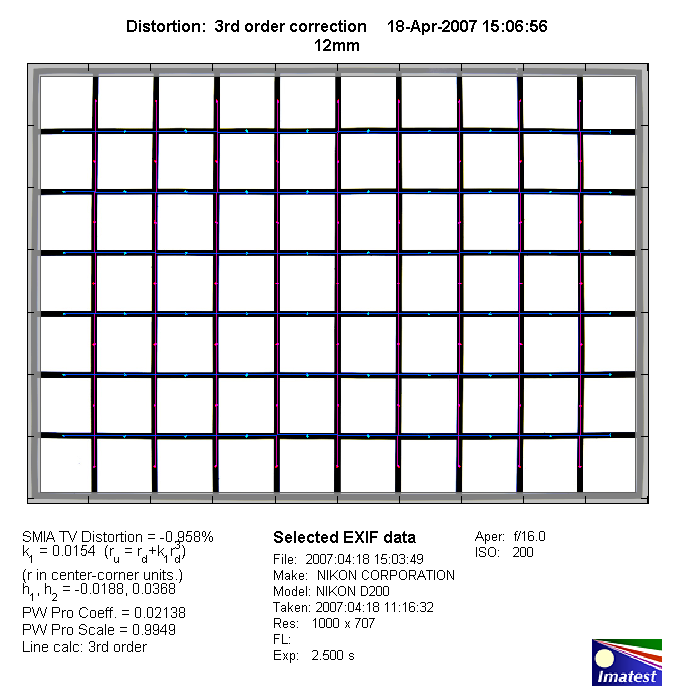| Lens Reviews - Canon EOS (APS-C) | |||||||||||||
Page 3 of 3 Sample ImagesALL IMAGES KINDLY PROVIDED BY PETER VAN DEN HAMER! Click on a thumbnail to view the original file (opens in a separate window). Please note that the originals are FULL SIZE samples (=several megabytes) thus requiring a significant amount of bandwidth so please take care of the limited resources here.
VerdictThe Tamron AF 11-18mm f/4.5-5.6 Di II SP is surely capable to deliver decent quality images but the truth is that the competition is generally better in most aspects. Regarding the comparatively slow speed (max. aperture), the subjectively lower build quality as well as the rather limited zoom range it is also a bit strange that Tamron is asking a higher price point compared to the Sigma and Tokina counterparts (locally at least). This doesn't seem to leave many arguments in favour of the lens.
| |||||||||||||
http://www.photozone.de/Reviews/Canon%20EOS%20Lens%20Tests/287-tamron-af-11-18mm-f45-56-di-ii-ld-aspherical-if-sp-test-report--review?start=2
Tokina AF 10-17mm f/3.5-4.5 AT-X DX Fisheye - Review / Test Report
| Article Index |
|---|
| Introduction |
| Analysis |
| Sample Images & Verdict |
Sample Images
Here're a few sample images taken with the D70s and D200 and RAW-converted via ACR. These images were kindly provided by HOLGER WINKELMANN. Click on a thumbnail to view the original file (opens in a separate window). Please note that the originals are FULL SIZE samples (=several megabytes) thus requiring a significant amount of bandwidth so please take care of the limited resources here.
|
| ||||||||||||||||||||||||||
|
|
Verdict
Fisheye lenses are special effect items so the sheer optical quality is not really a primary aspect. However, the Tokina does generally a very good job. It sharp enough for its purpose and the high degree of barrel distortion is naturally a feature to enjoy and not a bug. However, the Tokina lens clearly has some downsides. The primary weaknesses are chromatic aberrations (color shadows at the borders) and, more so, purple fringing (color blooming). Lateral CAs can be reduced easily via imaging tools but this is more difficult with PF. Compared to similar products such as the Nikkor AF 10.5mm f/2.8 DX or Olympus Digital Zuiko 8mm f/3.5 the price of the Tokina lens is very attractive at around 500€/US$. The Tokina has a superb build quality. Typical for fisheye lenses it's a hell of a fun to use but remember that this is not a mainstream lens like conventional (corrected) ultra-wide lenses.
| Optical Quality: |  (due to PF) (due to PF) | ||
| Mechanical Quality: |  | ||
| Price/Performance: |  |
http://www.photozone.de/Reviews/46-nikon--nikkor-aps-c/271-tokina-af-10-17mm-f35-45-at-x-dx-fisheye-review--test-report?start=2
Tokina AF 12-24mm f/4 AT-X Pro DX (Nikon)- Lens Test Report / Review
| Article Index |
|---|
| Introduction |
| Analysis |
| Sample Images & Verdict |
Sample Shots
Ok, finally here're some sample shots taken with the D200 (all converted RAWs via RSP 2006). Please note that RSP applies some degree of automatic CA correction. These images are test shots and surely not meant as a piece of art.Click on a thumbnail to view the original file (opens in a separate window). Please note that the originals are FULL SIZE samples (=several megabytes) thus requiring a significant amount of bandwidth so please take care of the limited resources here.
|
| ||||||||||||||||||||||||||
|
|
Verdict
The Tokina AF 12-24mm f/4 AT-X DX is a lens with many facets. The resolution characteristic is very good to excellent throughout the zoom range which is quite surprising for an ultra-wide zoom lens - more so for a third-party lens. Vignetting is very high at 12mm f/4 but quite well controlled otherwise (for an ultra-wide lens). It produces a fair amount of wavy barrel distortions at 12mm, less so at 18mm and at 24mm distortions are negligible. The weakest spot are CAs which are very high at 12mm and 24mm. This may not be a significant problem for RAW photography because CAs are a correctable problem but for those preferring JPEGs the issue may be quite annoying at times.Beyond CAs the lens doesn't really like contra light. Using the supplied hood is a good idea here and if possible light sources in the image field should be avoided. Typical for all Tokina AT-X lenses the build quality is on a very high level putting many lenses from other manufacturers to shame especially when considering the quite affordable price of around 450€/US$.
| Optical Quality: |  | ||
| Mechanical Quality: |  | ||
| Price/Performance: |  |
Tamron AF 17-50mm f/2.8 SP XR Di II LD Aspherical [IF] (Nikon) - Test Report / Review
| Article Index |
|---|
| Introduction |
| Analysis |
| Sample Images & Verdict |
Sample Shots
Finally some sample shots all taken with the D200 and RAW-converted via RSP 2006 (which applies some degree of CA correction).Click on a thumbnail to view the original file (opens in a separate window). Please note that the originals are FULL SIZE samples (=several megabytes) thus requiring a significant amount of bandwidth so please take care of the limited resources here.
|
| ||||||||||||||||||||||||||
|
|
Verdict
The Tamron AF 17-50mm f/2.8 XR Di II LD Aspherical [IF] is a very serious performer capable to deliver some of the best MTF50 figures to date in this lens class. Vignetting and distortions are about average for a lens in this class. CAs are very high at 17mm and 24mm. Mechanically the lens isn't top notch but it compares very well here to other third party lenses. AF accuracy could be a little better on the Nikon D200. Thanks to the very moderate price tag the lens is highly attractive and definitely worth a deeper look when shopping for a quality standard zoom lens for your APS-C DSLR and it's also a very interesting alternative to the genuine Nikkor standard zooms.
| Optical Quality: |  | ||
| Mechanical Quality: |  | ||
| Price/Performance: |  |
http://www.photozone.de/Reviews/46-nikon--nikkor-aps-c/290-tamron-af-17-50mm-f28-sp-xr-di-ii-ld-aspherical-if-nikon-test-report--review?start=2
Tamron AF 17-35mm f/2.8-4 Di LD Aspherical IF (Nikon) - Lab Test Report / Review
| Article Index |
|---|
| Introduction |
| Analysis |
Distortions
At 17mm the Tamron shows a very pronounced degree of barrel distortions (2.7%) which eases continuously towards the long end of the zoom range. At 35mm the lens is basically free of distortions.
| ||||||||
 | ||||||||
The chart above has a real-world size of about 120x80cm.
Vignetting
Full frame lenses enjoy a sweet spot advantage on APS-C DSLRs such as the Nikon D200 and the amount of vignetting is quite low accordingly. At 17mm @ f/2.8 vignetting is slightly more pronounced at around 0.7EV but relatively speaking this is already pretty good. As usual it helps a little to stop down but typical for wide-angle lenses you can't eliminate the issue completely. However, from f/4 onwards it should be rarely field-relevant - same goes for the other focal lengths. 
MTF (resolution)
The Tamron produced a very good performance in the MTF lab. The center performance is generally excellent at all focal lengths and throughout the tested aperture settings. At 17mm and 24mm and wide-open aperture the borders aren't quite as good but they easily reach very good quality from f/4 onwards. The lens shows a moderate degree of field curvature throughout the range.Below is a simplified summary of the formal findings. The chart shows in line widths per picture height (LW/PH) which can be taken as a quantity for sharpness. If you want to know more about it you may check out the corresponding Imatest Explanations.
 |  |
Chromatic Aberrations (CAs)
Typical for many wide to ultra-wide lenses chromatic aberrations (color shadows at harsh contrast transitions) are quite pronounced. This is especially true for the 24mm setting where CAs peak at around 1.8px on the average at the image borders at medium aperture settings.Please note that lateral CAs can be corrected via various imaging applications.

Verdict
The Tamron AF 17-35mm f/2.8-4 Di LD Aspherical IF SP proved to be a very decent standard zoom lens within the tested APS-C DSLR scope. The resolution figures are excellent in the center of the image and good to very good at the borders. Distortions are very pronounced at 17mm but very moderate otherwise. Typical for full frame lenses vignetting is very well controlled. CAs are a little on the high side specifically at 24mm. The build quality is generally pretty good but the direct competition does a little better job in this respect. When shopping for a new lens the Tamron AF 17-50mm f/2.8 SP may be a tad better and more versatile in terms of focal length range but without full format capabilities. If you prefer to have a lens living in both camps the AF 17-35mm f/2.8-4 Di SP may be still worth a deeper look.
| Optical Quality: |  | ||
| Mechanical Quality: |  | ||
| Price/Performance: |  |
http://photozone.de/Reviews/46-nikon--nikkor-aps-c/288-tamron-af-17-35mm-f28-4-di-ld-aspherical-if-nikon-lab-test-report--review?start=1
Sigma AF 10-20mm f/4-5.6 DC EX HSM - Lab Test Report / Review
| Article Index |
|---|
| Introduction |
| Analysis |
Distortions
The Sigma AF 10-20mm DC showed a rather unusual distortion characteristic. At 10mm most of the image field is almost free of distortions so the measured distortions figures look fairly fine here (taken a little inward from the extreme borders). However, this is only part of the truth. If you check the 10mm distortion chart below you will notice that the extreme corners are actually heavily (barrel-)distorted - probably in the 2-3% range. At 14mm the lens shows a moderate degree of pincushion distortions, even less so at 20mm.
| ||||||
 | ||||||
The chart above has a real-world size of about 120x80cm.
Vignetting
Typical for many ultra-wide zooms, especially those with an APS-C image circle, the Sigma also suffers from heavy vignetting problems which are most pronounced at 10mm @ f/4. At 14mm @ f/4.8 vignetting is not much better, a little less so at 20mm. One stop down from the max. aperture helps to reduce the problem to an acceptable degree. Ultra-wide lenses exhibit some "natural" vignetting so the issue doesn´t/cannot disappear completely. 
MTF (resolution)
The lens has been tested twice now with a clearly better 2nd sample (commented as follows). The center performance is exceptionally high at all tested focal lengths and aperture settings. At 10mm the border performance is easily on a very good level whereas the extreme corners show some softness at f/4. However, they catch up nicely by f/5.6 (very good). The lens is able to keep up the very good border performance at 14mm and 20mm. Quite impressive all-in-all.I should mention that the Imatest analysis tool had quite some problems to generate reliable test date at the "extreme borders" due to the combination of heavy distortions, CAs and field curvature. The readings are therefore less accurate than usual.
Below is a simplified summary of the formal findings. The chart shows in line widths per picture height (LW/PH) which can be taken as a quantity for sharpness. If you want to know more about it you may check out the corresponding Imatest Explanations.
 |  |
Chromatic Aberrations (CAs)
Lateral Chromatic aberrations (color shadows at harsh contrast transitions) are moderate for an ultra-wide zoom lens. At 10mm the average CA pixel width exceeds 1 pixels at the borders which is very decent relative to similar ultra-wide zoom lenses. However, it is also worth to mention that the CAs are much worse in the "extreme corners" peaking beyond 2px here. At 14mm and 20mm CAs are only a minor issue. 
Verdict
The Sigma AF 10-20mm f/4-5.6 EX HSM DC showed a very good performance during the tests especially in terms of resolution. There's some softness towards the extremes at 10mm @ f/4 but otherwise there's really nothing to complain here (within this specific lens class anyway). The vignetting and distortions are quite comparable to the rest of the gang. Lateral CAs are generally well controlled except in the extreme corners of the image field. The Sigma offers a little extra kick regarding the widest setting (10mm vs 12mm of the Nikkor or Tokina) so the quality is fairly impressive regarding the increased design complexity here. The build quality is very good and the AF is both fast and virtually silent. If you're looking for a candidate in this class the Sigma is worth a look but watch out for sample variations.
| Optical Quality: |  | ||
| Mechanical Quality: |  | ||
| Price/Performance: |  |
http://www.photozone.de/Reviews/46-nikon--nikkor-aps-c/308-sigma-af-10-20mm-f4-56-dc-ex-hsm-lab-test-report--review?start=1
Sigma AF 12-24mm f/4.5-5.6 EX HSM DG - Lab Test Report / Review
| Article Index |
|---|
| Introduction |
| Analysis |
Distortions
The Sigma shows a quite unique distortion characteristic for an ultra-wide angle lens - it is extremely well corrected here with only minimal distortions even at 12mm. The lens is basically free of distortions at 24mm. The remaining distortions are slightly wavy in style though.
| ||||||||
 | ||||||||
The chart above has a real-world size of about 120x80cm.
Vignetting
The Sigma is a full format lens thus enjoying a sweet spot advantage on APS-C DSLRs. At 12mm vignetting is still quite pronounced although not excessive at f/4.5. At all other settings the problem is very well controlled for such a lens. 
MTF (resolution)
The Sigma AF 12-24mm EX produced very good resolution figures throughout the tested aperture and focal length range. There're competing lenses with a better center performance out there but the resolution characteristic is unusually even across the APS-C image frame - even at the extreme borders at 12mm. A nice side effect of the full format nature of the lens.Below is a simplified summary of the formal findings. The chart shows in line widths per picture height (LW/PH) which can be taken as a quantity for sharpness. If you want to know more about it you may check out the corresponding Imatest Explanations.
 |  |
Chromatic Aberrations (CAs)
The Sigma has not many weaknesses but it has definitely one - lateral CAs (color shadows at harsh contrast transitions). At 12mm and 17mm CAs are quite extreme and not really acceptable unless corrected via imaging tools (like most RAW converters). The CA situation is quite good at the long end of the zoom range. 
Verdict
The Sigma AF 12-24mm f/4.5-5.6 EX HSM DG is the most extreme full format ultra-wide zoom lens around and it is still a "mainstream" ultra-wide lens when used on APS-C DSLRs. If you're looking for a future-proof "duo-format" lens in this class - well, here it is. However, there're a couple of further good arguments in favor of the lens. In the APS-C scope the resolution is very high and even throughout the tested aperture and focal length range and as such more harmonious compared to dedicated APS-C zooms which tend to suffer from edge problems. Distortions are extremely well controlled for a lens in this class and vignetting is generally not a problem except maybe at 12mm @ f/4.5. The only significant issue are lateral CAs at and below 17mm - you better shoot RAW files and correct the issue in your RAW converter, otherwise CAs are too extreme. The build quality of the Sigma is excellent and the fast and near-silent HSM (ultrasonic) AF drive is a welcome feature. The price tag of the lens is fairly moderate in relation to what you get for your bucks. Highly recommended ... if you can get a good sample (the tested sample in Canon mount wasn't quite as good).
| Optical Quality: |  | ||
| Mechanical Quality: |  | ||
| Price/Performance: |  |
http://www.photozone.de/Reviews/46-nikon--nikkor-aps-c/310-sigma-af-12-24mm-f45-56-ex-hsm-dg-lab-test-report--review?start=1
--
[垃圾桶] 裡沒有會話群組?


















沒有留言:
張貼留言